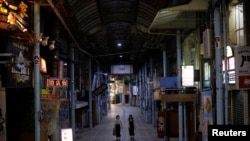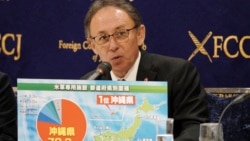U.S. military bases in Japan tightened coronavirus prevention measures Thursday, after an explosion of infections in Okinawa, a southern prefecture that hosts dozens of U.S. military facilities.
Since mid-December, about 1,000 U.S. military personnel on at least eight bases in Japan have tested positive for COVID-19, according to Japanese media reports quoting local officials. The outbreak began at Camp Hansen in Okinawa.
Japanese officials have expressed growing concern about the U.S. outbreak, especially as cases nationwide began to surge last week following months of success containing the virus.
Okinawa, which hosts more than half of the approximately 50,000 U.S. troops in Japan, has suffered the worst of the surge. On Thursday, Okinawa reported a record high of nearly 1,000 new cases. That figure represents nearly a quarter of the cases reported nationwide, even though Okinawans comprise just 1% of Japan’s population.
The situation underscores the pandemic challenges faced by the U.S. military, which regularly rotates troops through bases worldwide. It also risks inflaming tensions in Okinawa, where many residents have long resented the U.S. military presence.
“It’s really scary. The number of new infections just tripled in one day,” said Manabu Sato, a professor of political science at Okinawa International University. “Okinawa, as you may know, is an isolated island. We cannot ask for help from neighboring prefectures easily.”
In a phone call Thursday with his U.S. counterpart, Antony Blinken, Japanese Foreign Minister Yoshimasa Hayashi requested U.S. bases impose curfews and other measures to contain the outbreak, according to Japanese officials.
Shortly after news of the phone call emerged, U.S. Forces Japan announced new measures, including requiring personnel to wear masks off base and tightening testing procedures.
“The mitigation measures we have instituted throughout USFJ are intended to protect our force’s readiness, the well-being of our families, and the health of Japan’s citizens,” the statement read.
Late last month, the U.S. military in Japan acknowledged that since September it had stopped requiring COVID-19 tests for vaccinated American personnel arriving on military aircraft at U.S. installations. After senior Japanese officials expressed “strong regret” about the policy, U.S. Forces Japan reinstated the test requirement and tightened restrictions on movement.
Local concern
Among those most critical of the U.S. military’s COVID-19 approach is Okinawa Governor Denny Tamaki, who has long supported reducing the U.S. military presence on the island. Earlier this week, Tamaki said he is “outraged” at the uptick in cases among U.S. personnel, saying it suggests "insufficient" military management, according to local media.
In an editorial Thursday, the left-leaning Asahi Shimbun said the Japan-U.S. Status of Forces Agreement, which exempts U.S. military personnel from Japan’s civilian immigration rules, was serving as a “loophole” for the more transmissible omicron variant to enter Japan.
Sato, the Okinawa-based professor, said many locals have a “strong suspicion” that Okinawa’s outbreak is related to the U.S. military infections, but that this is hard to determine because of a lack of public data from the U.S. side.
“I don’t think it’s fair to blame anybody for this (pandemic). But we have to find out how to limit this spread. And in order to do that, we have to have information,” he added.
Late last month, U.S. officials promised Tokyo they would conduct tests to detect the omicron variant and would inform Japan about the results as soon as possible, according to Japan’s foreign ministry.
Transparency
Most of the publicly available data on coronavirus outbreaks at U.S. bases is released by Japanese prefectural officials. The U.S. military in Japan publicly releases limited information about its outbreaks.
By contrast, the U.S. military in neighboring South Korea has provided more frequent public updates about positive cases among U.S. personnel.
“I chose to release the numbers in the interest of keeping our community informed. This provided transparency for both our own population and (South Korean health authorities),” General Robert Abrams, who until July was the top U.S. commander in South Korea, told VOA.
Abrams, who is now retired, oversaw the fight against the coronavirus on U.S. bases in South Korea, which were effectively the first U.S. community to be on the front lines against COVID-19.
Beginning in November, U.S. Forces Korea reduced the amount of COVID-19 data it releases to the public, but still publishes a weekly count on its website.
For the week ending January 3, USFK reported 682 COVID-19 cases. Stars and Stripes, a newspaper focusing on the U.S. military, reported that figure was USFK’s highest weekly total yet.
But the USFK cases may appear less glaring since they are set within South Korea, which for months has experienced a winter wave of infections.
Japan on Thursday reported 4,000 cases, according to a count by national broadcaster NHK. That is the most cases reported by Japan since mid-September.






